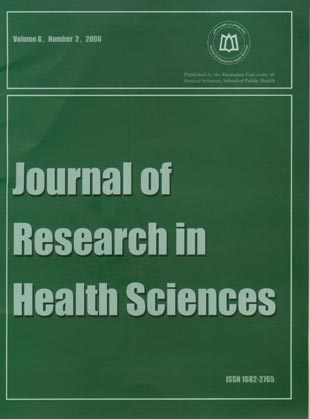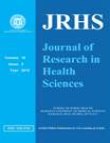فهرست مطالب

Journal of Research in Health Sciences
Volume:6 Issue: 2, Summer-Fall 2006
- 52 صفحه،
- تاریخ انتشار: 1386/08/01
- تعداد عناوین: 9
-
Page 1BackgroundIn a variety of industries, accreditation is recognized as a symbol of quality indicating that the organization meets certain performance standards. In this regard, health records are among the pri mary documents used by health care facilities to evaluate compliance with the standards set by the ac creditation agencies. This study compares the strengths and weaknesses of Information management(IM) standards of three well-established national accreditation agencies in Canada, USA and New Zealand.MethodsThis was a comparative–descriptive study in which the IM standards for the national accredita tion agencies of Canada (CCHSA), USA (JCAHO) and New Zealand (QHNZ) were collected and investi gated through the internet, and e-mail.ResultsAll of the accrediting agencies have accepted reliability, accuracy, and validity as data qual-ity. JCAHO and CCHSA have adopted maximum standards related to evidence-based decision-mak-ing. Achieving positive outcomes was adopted by CCHSA and QHNZ, and is among the strongest points of their standards.ConclusionThese review findings revealed that the CCHSA and QHNZ had adopted the same stan-dards with emphasis on information management planning, achieving positive outcomes and making im provement. While the strong points of JCAHO’s standards are patient specific information and evi-dence-based decision-making.
-
Page 8BackgroundThe classical supportive therapy for? -thalassemia major consists of regular blood transfusion, iron-chelation therapy and specific treatment of the related complications. A balance be-tween the maintenance of the highest possible level of haemoglobin and lowest possible level of iron accumulation in heart and liver give the best chance of survival and the best quality of life.MethodsFor the first time in Iran, we report the survival chance calculated on a cohort of 101 trans-fusion dependent individuals using Kaplan-Meier analysis. Several factors were included in our study including gender,? -globin genotype, Ferritin level, blood group and access to transfusion, socioeco-nomic status and type of transfusion protocol.ResultsThe survival rate was observed in the first decade of life. While life expectancy up to the age is satisfactory, our study is focused on the decline observed in the second decade of life. Our data shows that 68% of the patients reaches 20 years of age and that prospectively only 50% will still be alive at age 30.ConclusionAlthough information and transfusion protocols play a role, the most important factors influencing the survival rate observed in this study are the ferritin level and the molecular back-ground.
-
Page 14BackgroundAsymptomatic bacteriuria (ASB) is common among women with diabetes. The aim of this study was determine the prevalence of and risk factors for ASB in women with diabetes type 2 in Shahre-kord city of Iran.MethodsIn a six months period (April- September 2005), a total of 100 women with diabetes (type 2) and 100 healthy women without diabetes as control group were investigated for the presence of ASB. After a follow-up of six months, the rate of developing of ASB to symptomatic urinary tract in-fection (UTI) in pa tients was evaluated.ResultsThe prevalence of ASB was 20% in the diabetic patients and 4% in control group (P< 0.05). Es cherichia coli, Coagulase negative staphylococci, Enterococcus spp. and Klebsiella pneumoniae were the most prevalent isolates respectively. Pyuria was present in 80% of patients with ASB and in 17.5% of those without ASB. Symptomatic UTI in previous year was the only risk factor for ASB in the patients (P< 0.05). During a follow-up of six months, 40% of diabetic patients with ASB devel-oped to symptomatic UTI.ConclusionsThe prevalence of ASB is increased in women with diabetes and we recommend screening for detection and treatment of ASB in diabetic patients.
-
The Effect of Ramadan Fasting on Hemoglobin, Hematocrit and Blood Biochemical ParametersPage 21BackgroundPhysicians in Islamic countries believe that fasting in Ramadan is equal to ingestion of thirty pills regularly ingested every year for clearing the blood and fortifying the tissues. The effects of Islamic fasting on physiologic functions in normal conditions have been considered in different studies and different topics. This study was to determine the quantitative changes of hemoglobin, hematocrit and certain serum biochemical parameters during Ramadan fasting in apparently healthy Muslim col lege students.MethodsSixty-two students were followed in five stages: one week before, 3rd, 15th and 28th day of Ramadan and ten days after Ramadan, by proper blood sampling in suitable time of day.ResultsThe findings showed a significant decrease in hemoglobin, glucose and uric acid on days 3 and 15 of Ramadan (P< 05), a significant decrease in low-density lipoprotein cholesterol and glucose on day 28 of Ramadan and a significant increase in blood urea nitrogen and high –density lipoprotein cholesterol on day 28 of Ramadan (P< 05)ConclusionChanges in biochemical and hematological parameters of blood during Ramadan fasting are very important and the Islamic countries physicians should be informed about these beneficial ef fects of fasting. It seems that more researches are required for evaluating these effects in various physiologic and pathologic conditions and there are yet many unanswered questions in this relation. We believe that one of the physician responsibilities about patients is guiding and helping them for doing the religious duties in disease conditions because this has a great effect on recovery of patient. This consideration makes strong the physician-patient relationship.
-
Page 28BackgroundIn this study we evaluated the knowledge and practice of patients with breast cancer about com plication of chemotherapy referred to chemotherapy ward of Nemazee Hospital in Shiraz, Shiraz Prov ince, Iran, in 2004.MethodsForty patients suffering breast cancer and under chemotherapy, were selected with a simple ran dom sampling method. All were interviewed and a questionnaire was completed for each by trained inter viewers.ResultsOverall correct responded answers were 30% in knowledge part and 53% in the practice part. There was no relation between knowledge and practice of patients with demographic variables (P> 0.05). Con sidering the episodes of chemotherapy, only in the knowledge part the women who were attend ing to receive third episode of chemotherapy had more awareness (P< 0.004). The sources of pa tients'' informa tion in this regard were as fallows: 18% by nurses, 82% by themselves and 0% by physi cians.ConclusionAccording to the results, it seems that unfortunately there is not effective education about che motherapy complication, because their knowledge and practice were not in acceptable level. Con-sider ing the importance of this subject, it is needed to having educational program for patients to im prove patients'' ability and skills for coping chemotherapy and its side effect as well as adapting ill-ness
-
Page 33kground: This study was conducted to determine the species of oral and non-oral microorganisms in dental laboratory pumice in order to undertake the necessary disinfection control protocols.MethodsFourteen active and well-known dental laboratories of Tehran entered our study. Samples of pumice were collected from polishing containers in a completely sterilized and controlled condition. They were immediately sent to Microbiology laboratory and were cultured in specific media in order to identify the aerobic and anaerobic bacteria and also genera of fungi.ResultsMicroorganisms recovered from pumice were shown in frequency order as follows: Acine-tobac ter lowffi, Bacillus cereus, Staphylococcus aureus, Pseudomonas aeruginosa, Diphteroids, Serra tia mercescens, Enterobacter aerogenes, Morganella morgani, Providencia rettgeri, Staphy-lococ cus albidus and Streptococcus Sanguis. Therefore both oral and non-oral bacteria were visible. The iso lated fungi were Aspergillus niger, fusarium sp., Aspergillus flavous, Cephalosporium sp. and pencil lium sp.ConclusionThis study showed that polishing pumice was contaminated by both oral and non-oral bacteria and fungi. Therefore, the chance of cross-contamination still severely exists, and measures should be conducted to prevent the contamination of technicians, dentists and patients.
-
Page 39BackgroundHuman T-lymphotropic virus type I is the etiologic agent of two distinct human dis-eases, adult T-cell leukemia or lymphoma and a chronic, progressive demyelinating disorder. The aim of this work was to investigate the seroprevalence of HTLV-1/2 among high risk patients (thalassemic and hemodialysis) in Charmahal-va-Baktiari Province, center of Iran.MethodsUsing ELISA, a total of 357 serum samples from the patients were tested for HTLV spe cific antibody during first 6 month of 2005. Seventy percent of samples were thalassemics and 30% were hemodialysis patients. All of the ELISA positive samples were confirmed by Western blotting (WB) analysis.ResultsUsing ELISA, 27 of 357 (7.6%) serum samples tested positive for HTLV-1 specific antibody of which 18 (7.2%) were thalassemic and 9 (8.4%) were hemodialysis patients. The WB results showed that of 27 samples tested positive by ELISA, 24 (89%) were HTLV-1 and 3 (11%) were not confirmed.BackgroundDiabetes mellitus has a strong association with the presence of depression. Psychiatric morbid ity and especially depression are believed to be important aspects of diabetes influencing upon treat ment course and prognosis. To determine the prevalence of depression in adult diabetic popula-tions and compare nondiabetic population, we performed the current study.MethodsThree hundred eighty four diabetic patients from a diabetic research center in Hamedan, Iran and 384 nondiabetic participants involved in this cross-sectional study. The Beck Depression Inventory (BDI) was used to evaluate depression.ResultsThe diabetic patients group had a significant higher mean BDI score than that of the nondia-betic group. In addition, patients with diabetes type I had a significant higher mean BDI score than that of the diabetic patients type II. Outcome showed the prevalence of mean BDI score was 29/4% in fe males compared with 21.8% in males.ConclusionThis study highlights the importance of this point for healthcare workers to understand how diabetic patients experience depression, which is a prerequisite for communication based on a shared understanding. This awareness would enhance nurses` opportunities to alleviate suffering.
-
Page 44BackgroundHuman T-lymphotropic virus type I is the etiologic agent of two distinct human dis-eases, adult T-cell leukemia or lymphoma and a chronic, progressive demyelinating disorder. The aim of this work was to investigate the seroprevalence of HTLV-1/2 among high risk patients (thalassemic and hemodialysis) in Charmahal-va-Baktiari Province, center of Iran.MethodsUsing ELISA, a total of 357 serum samples from the patients were tested for HTLV spe cific antibody during first 6 month of 2005. Seventy percent of samples were thalassemics and 30% were hemodialysis patients. All of the ELISA positive samples were confirmed by Western blotting (WB) analysis.ResultsUsing ELISA, 27 of 357 (7.6%) serum samples tested positive for HTLV-1 specific antibody of which 18 (7.2%) were thalassemic and 9 (8.4%) were hemodialysis patients. The WB results showed that of 27 samples tested positive by ELISA, 24 (89%) were HTLV-1 and 3 (11%) were not confirmed.ConclusionThe relatively high seroprevalence of HTLV-1 among both thalassemic and hemodialy-sis patients was de termined in this province. This might indicate this region as an endemic area for this virus. However, to approve this hypothesis, the prevalence of this virus in the blood donors has to be determined.
-
Evaluation of QIAamp DNA mini kit for removing of inhibitors in detection of Cryptosporidium parvum oocysts in water samples by a nested- PCR assayPage 66


